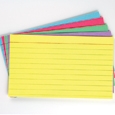I am an organized person, but when it comes to band directing, no matter how organized I am, it still seems like I am unorganized. There is always one more paper I can shuffle or file that I can file. Modern technology has certainly helped to a great degree; I wouldn’t trade my computer or smartphone for anything. Still, there is something to be said for going old school. Below are some old-school ideas I use to fight the never-ending organization battle.
Multi-Colored Flair Pens
When taking notes and making lists, the varied colors add contrast to ideas; I can use bright colors to make more important ideas stand out. It also makes things more visually interesting. (If that sounds eccentric, so be it!) On music scores, I use different colors to notate different things, such as red for notes in the percussion lines and blue in the brass. In private lessons, I also use them to add accidentals to a student’s music so that they stand out.
Multi-Colored Highlighters
These are great for marking my scores and for students to use in marking the dynamics in their music. Some people might not like marking up the music that way, but if it makes a performance more musical, I’m all for it.
Silver Sharpies
The silver color really stands out on darker surfaces and comes in handy when you have to put some type of identifying mark on a dark, difficult surface. I use them to write the school name and serial numbers on the outside of instrument cases.
Red Pencils with My Name on Them
A few years ago, I got so tired of loaning out pencils and never seeing them again that I decided to do something about it. I bought a pack of 100 red pencils with “Return to Mr. Reely” on them. Now if a student leaves a pencil on the floor, I know if it’s mine. If I see a kid carrying a red pencil around in the hall, I can investigate with confidence and confiscate it if appropriate.
Visual Reminders
One of the most annoying aspects of band directing is when students leave their instruments at home. I coach them on using visual reminders so that maybe it won’t happen again. (I say maybe because my youngest son once managed to get by his football pads when they were stacked in front of the back door. I’m still not sure whether he climbed or jumped over them.) I ask students if they have anything that they always bring to school with them; usually they will say a backpack. I then suggest that they put the instrument in the backpack or by the backpack. If that is not an option, I tell them to put the instrument in front of the door that they use to exit so they basically have to trip over it to get out.
Sticky Notes
I have almost completely eliminated students asking me about what we are going to do or what time we are going to do it. The trick is that I put announcements on the whiteboard at the front of the class. I also have a whiteboard just for the color guard on their storage room door because their information is often different from other band members. In addition, there is a small white board by my office door as a last line of defense. Students are trained to look at that board for information before they walk in and ask me a question. To complete the information onslaught, I do use some modern technology: a text-messaging smartphone app called Remind works well for sending out information.
Multi-Colored Paper
Sometimes if there is something important that I need to remember, I will write it in large letters on a fluorescent-colored sheet of paper and place the reminder in my briefcase so that when I open the case at home it will be difficult to miss. The bright colors also enable me to find papers more easily around the office. I may not remember exactly where I put something, but I can remember to look for the bright pink sheet. Trying to find a specific sheet of white paper is sometimes like looking for cotton balls in the snow.
Multi-Colored Index Cards
If you haven’t figured it out already, I like things in color. (I used to avoid watching black and white movies until Ted Turner colorized them.) Index cards have many uses and the varied colors make them easier to find and can be used to categorize different types of lists. Perhaps the most obvious use is a to-do list, but what is great about using index cards for this is that it forces you to be concise.
Index cards are also useful for taking notes. When I am in a meeting, a notecard is a handy way to write down salient points. If the meeting was a waste of time, I can easily toss the card into the trash can when I get back to my office.
I often have several things that I need my assistant director to do, so I make a list on an index card and pass it along. Leaving a note for him is much more efficient than depending on both of our memories.
Notecards are also ideal reminders. Need to remember to do something in the morning? Write it down on a card and place it somewhere like the breakfast table so you won’t forget it.
Clipboards
I have more clipboards than a doctor’s office. In fact, I have so many that I keep them on a Rolodex-like frame for easy access. Even when I use colored sheets of paper, I sometimes find that they will hide under other papers like a snake in the grass. With clipboards, it is more difficult for papers to get buried. Also, when I need to take papers home, they are easier to find in my briefcase if they are attached to a clipboard. Clipboards are also great for bus lists and any sheet to be passed around for signatures.
Everything in Its Place
Keys, pens, smartphones, and clothing hunts can cause distraction and frustration, especially when time is of the essence. One would think that putting items in an unusual place would be easy to remember, but that is actually not the case.
Have definite places to put things and never vary. It is best to have a specific location, but if you want more flexibility, have two or three places. My car keys and wallet have one place, and my smartphone is always in one of three places: by my bedside, on the piano (a good central location), or on the den table where I often use a laptop. This concept is even more important at work, where it is even easier to misplace things. I try to avoid setting anything down temporarily with the intention of getting it later; I take the time to put things where I always put them. This goes for batons, music scores, roll books, invoices, and method books.
According to OrganizedWorld.com, the average office employee spends one and a half hours a day (six weeks per year) looking for things. I am unsure where I line up in that statistic, but my search time is reduced using some of these old-school methods. You may prefer to use your smartphone or tablet for such things, but make sure you can always find them when you need them.






